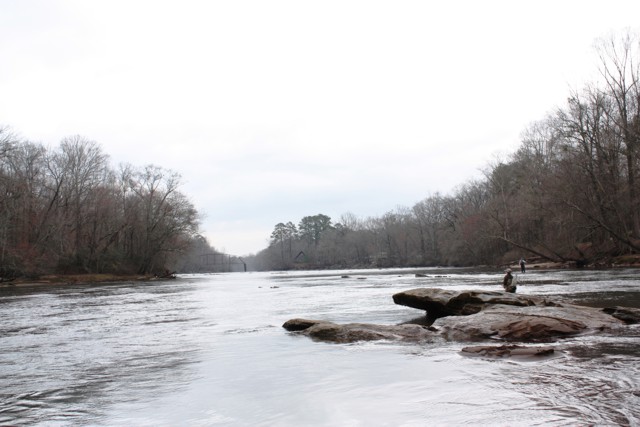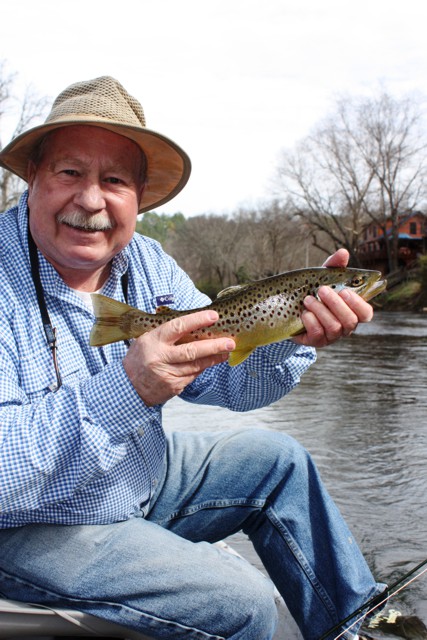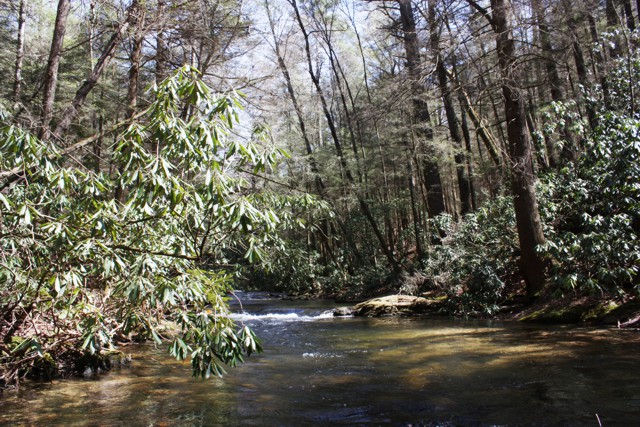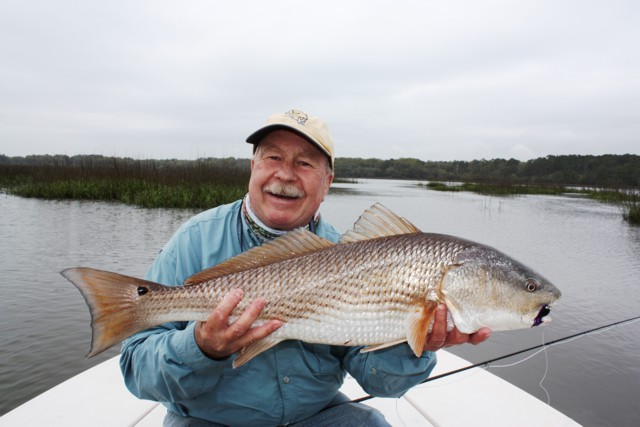Imagine a place with palmetto palms, swamps full of alligators, downhome Southern cooking and trout streams - one whose cosmic blue waters flows through the state’s largest city. Wait a minute. All the dots line up except the last one. Trout and predatory reptiles don't cohabit. Right? Well they do in Georgia. While gators and rainbows don't exactly share the same drainage, they are both present which is only one of the many paradoxes of this quintessential southern state.
While Snow Zone anglers traditionally beat the mid-winter blues by escaping to tropical destinations like Cuba, the Bahamas or Belize, a white-month getaway to the Peach State - especially in mid-March or April when spring is busting out - is a great way to jump start your fly fishing season. Plus you get to enjoy a Dixieland Delight of southern hospitality, loblolly pine forests and sublime Old South architecture. Here’s a seductive sampling of some of the angling adventures that Georgia has to offer.

Anglers on Georgia’s historic Chattahoochee River
Georgia and several other southern states are now blessed with trout streams where historically their waters were too warm, turbulent and environmentally inhospitable for any cold water fish species to survive. These came about through a combination of the Tennessee Valley Authority, the Army Corps of Engineers and U.S. President Franklin Roosevelt’s "New Deal" legislation where in the name of flood control, power generation and job creation during the economic ravages of the Dirty Thirties, many southern rivers were dammed and tamed. Trout fishers are usually not great fans of impoundments. In the case of the dams, however, they had a transformative effect on many of the rivers when cool water releases from the bottom of the newly constructed reservoirs allowed trout to survive and thrive in these man-made tailwaters.
The Chattahoochee River, from where it passes under the Buford Dam on Lake Lanier and skirts around the City of Atlanta, is one of those sublime southern rivers. It seems out of context to see Canada geese in what clearly qualifies as the Heart of Dixie. But as I string up my four-piece travel rod and pull on my waders at the Jones Bridge Recreation Area in Atlanta’s northwest suburbs, paired-up Canadas glide over the Chattahoochee’s cobalt blue riffles. The Georgia Department of Natural Resources stocks 170,000 rainbow and brown trout in the tailwater each year and my intention is to hopefully catch a few.
The park is the site of an old toll bridge. Part of the span still hangs precariously over a 100 meters or so of granite shoals which the river pours over and splits into numerous glides and runs. It’s also what attracts a good representation of Atlanta’s fly fishing community on a pleasant spring afternoon. I find an unoccupied slot where the Hooch slides over a rock and begin swinging a Black Woolly Bugger with a Pheasant Tail Nymph on the dropper. Southern rivers, unlike their Canadian counterparts, don't have expansive floodplains and meandering water courses. They are confined to their banks and are usually over-hung with fly-eating trees. I work the flies through the sweet spot a couple of times and on the third I get a bump. On the next pass the trout takes the Pheasant Tail. A little brown which I shake off. This is going to be easy. Not! With the rest of the Georgia fly fishers I flogged the Chattahoochee for a good hour without a touch. Then, like somebody flipped a switch, there’s a bite and for a while everyone seems to have a fish on including a 12-inch rainbow that took the Copper John nymph I had switched to. Sadly, overall on that afternoon the Chattahoochee was more pits than a peach.
Toccoa River
The explanation for Georgia’s angling dichotomy are its mountains. Tucked away in the northern corner of the state are the southern terminus of the Appalachians - the great spine of eastern North America from which numerous famous trout rivers emerge. In Georgia they are called the Blue Ridge Mountains and in neighboring North Carolina they influence the climate enough to allow ski hills. The Toccoa, like the Chattahoochee, is also a tailwater, but is one of those seminal Blue Ridge mountain streams. In alpine terms the Georgia mountains are more relevant to Alberta’s Swan or Cypress hills than they are to the Rockies.

A fine Toccoa River brown trout
Still they are alive with gobbling turkeys and singing birdlife when river guide Hunter Barnes launches his drift boat down a steep bank to the benign Toccoa. I'm fishing out of an old railway town called, if you can believe it, Blue Ridge, and Hunter has rigged me with a Copper John under a rubber-legged stone fly nymph. The strike indicator is a hopper imitation called a Chubby. We drift along under a budding canopy of southern trees that I don't know the names of, casting and mending the flies through the glides and beneath over-hanging bushes. After two blown strikes, I finally get a hook-up. A stocker rainbow and now that I've got my striking rhythm down, many more follow until the guide holds the boat alongside a scour where the Toccoa drops over a little shoal. The indicator twitches and I raise the rod tip. The weight at the end of the line and a golden flash tells me this is no hold-over rainbow. When the dealing is finally done a wild 16-inch brown trout slides into Hunter’s net to be admired, photographed and released. The day’s tally is 19 trout and a bonus smallmouth bass.
The Tumbling Noontoola
While Georgia’s big trout waters are nice, they exist because of the intervening hand of man. It is, however, the little brooks that come tumbling out of the mountains, through cool tunnels of leafy rhododendron bushes, where the mythology of southern trout fishing was created. Tiny, exquisite creeks at the extreme edge of the trout universe, surviving where no cold water critter should rightly be. Many in the Smoky Mountains National Park and in some of the higher Georgia trickles still have surviving native brook trout. Noontoola Creek, which comes rushing out of the Chattahoochee National Forest near the southern terminus of the great Appalachian Trail, somewhere along the way lost its brookies and have now been replaced with feisty rainbows. The creek has a minimum 16-inch retention limit meaning it’s in reality a catch and release water.

Noontoola Creek, a Blue Ridge Mountains classic
The idea of frying any of these precious little specimens is the furthest from my mind, when I pull the rental off the U.S. Forest Service track that twists and turns up Winding Stair Gap. The sweet serenade of a singing creek hits my ears as soon as I open the door. This is National Forest property so getting on is not an issue but further down the drainage where the Noontoola flows through agricultural bottom land access is strictly private. I knot on an Elk Hair Caddis dry fly and suspend a Hare’s Ear nymph below it. Here the creek’s descent is rapid, curling around bounders and under leafy over-hangs. Classic small stream, stair-case pocket water where back-casting room is minimal and flips and flops are how you progress upstream. Somehow you make it work. At the first pool, where the creek spills over a rock barrier, the Elk Hair twitches and I set the hook. The rainbow punches above its weight. Eventually the spine of my fly rod breaks its spirit and the little male slides into the net to be unhooked, admired and released - a true Southern Gentleman. So it continued for the next four hours as I worked my way up the gap.
Hilton Head-banger
Like I said, Georgia is a state of contrasts and contradictions. In the north the woods are full of black bears and cosmic little wild trout streams. However, where the Savannah River meets the Atlantic Ocean there’s a matrix of creeks, canals and sea grass that extends from South Carolina almost to Florida known locally as the Low Country.
The quixotic colonial city of Savannah - with its shady live oaks, dazzling azaleas and meticulously laid-out squares - is a frozen-in-time architectural masterpiece. I've come to this pleasant corner of Georgia for that few hours each day when the pull of the moon causes sea water to surge into the grass, making it possible for flats guide Mark Nutting to poll his skiff in pursuit of the tailing redfish brought in by the rising tide. We're north of the Savannah River with Hilton Head Island in the distance, so technically this is South Carolina.

Hilton Head Island redfish
The flat is as wild and empty and quiet as when Blackbeard the pirate once pillaged here. That is until the crackle of an F-18 fighter taking off from the Marine base on Parris Island snaps you back to reality. There’s a pink tail with a spot poking out of a pocket in the grass but I blow the cast and the redfish evaporates. We work the grass until a squall kicks up and we have to run. It’s getting late now and the tide is in full ebb but Mark knows a last chance oyster bed up Harbour River. It’s blind casting now and the skiff keeps running aground. I load up my 8-weight fly rod and fire a Loco Crab at a grassy point and something big slams it on the first twitch. My Hilton Head-banger departs in a hurry. I discover oyster beds are not the best places to fight a large and angry fish. Somehow the 0X tippet doesn’t get sawed off in the tussle and soon the guide scoops the big redfish in his net. Yes!
Travel Tips
Fly fishing getaways to Georgia or other exotic destinations are a great was to beat the winter blahs. That is especially true when you can combine a little sight-seeing, fine dining, entertainment and a few quality days on the water. Access is always an issue when traveling to new territory for a short period of time and I suggest, if it fits your budget, hire a guide. It is a way of flattening the learning curve and I was glad that I did for two of my Georgia angling experiences. You forfeit some of your angling autonomy but, then again, you'll boat more fish and get on water you wouldn't otherwise have a shot at. Life is all about compromises.
Having travel-friendly tackle - especially rods that will pack away in the bottom of a duffle - is another way of lessoning you anxiety. Doing your homework beforehand and planning your movements on the ground also takes away a lot of angst. Remember, you're never going to be able to see and experience everything. So narrow focus on what you feel is important and be willing to roll with the punches.


